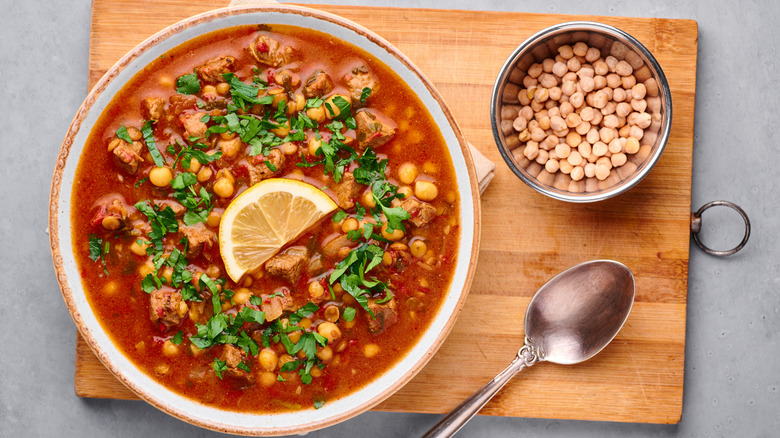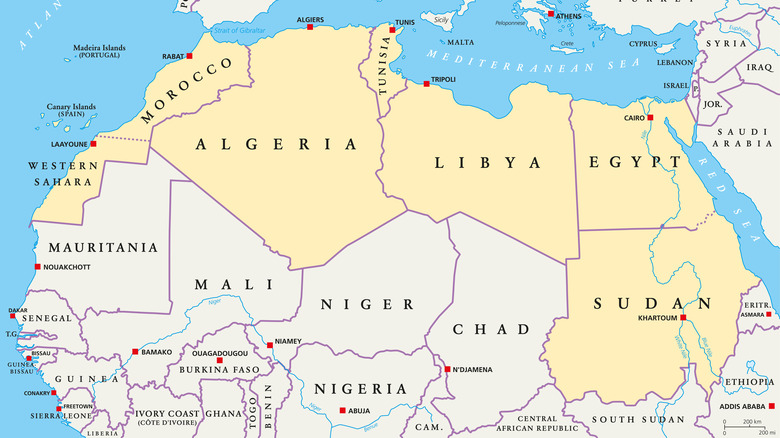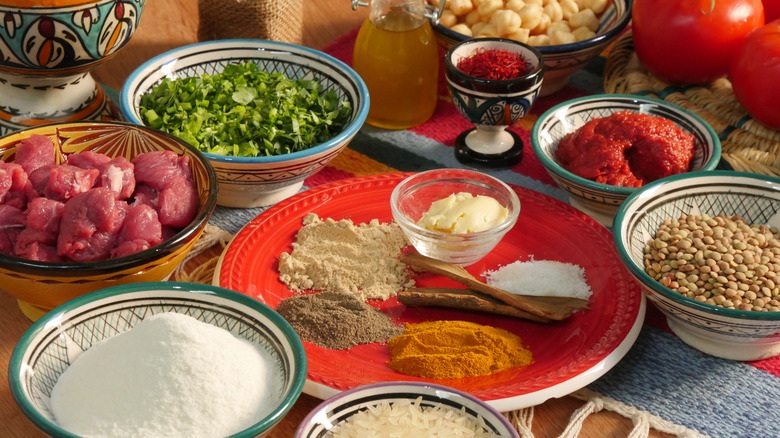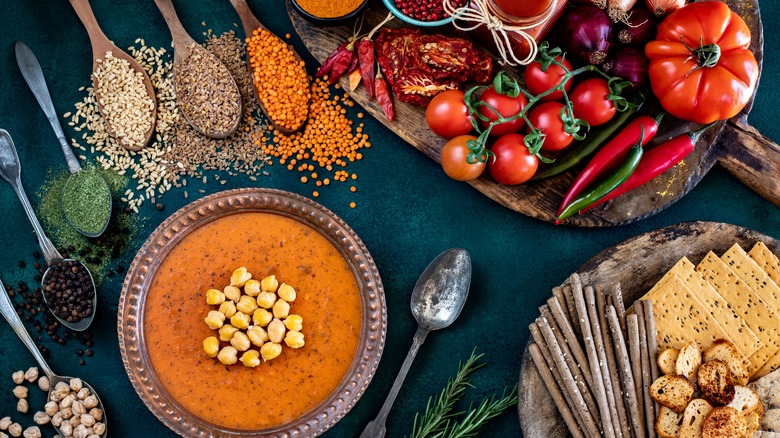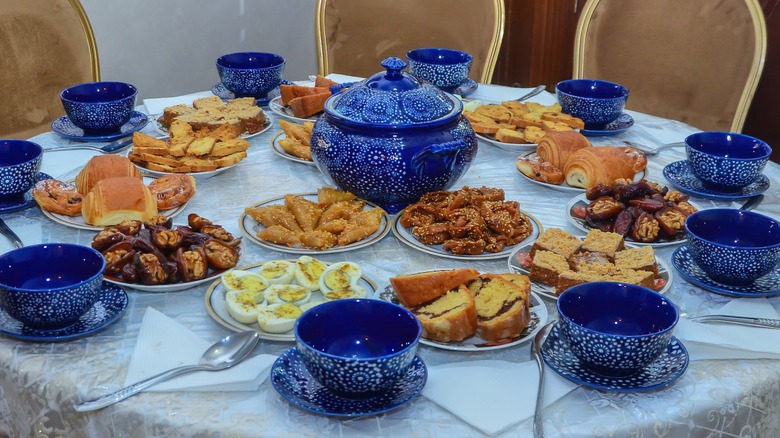Harira: The Traditional Moroccan Soup That Packs In Flavor
Harira, or "7arira," as its commonly spelled in Arabic, per The Culture Trip, is a tomato-based soup that is synonymous with Moroccan cuisine. Rich, herby, and silky smooth, harira packs all the heartiness, flavor, and texture you crave on a cold, rainy day. In fact, its name stems from the term "hareer," which, according to Taste Atlas, translates from Arabic to the word to describe the feeling of velvet.
As one of the nation's many specialties, per Britannica, harira is the most popular soup in Morocco. With high rankings on everyone's lists of must-try Moroccan foods, it can be found in Moroccan homes and restaurants all year round. However, should you take a trip to the north African country during the winter months, you'll find harira being served as commonly as street food in some of the most modest-looking roadside cafes — just don't expect any one bowl to taste like the next.
History
Despite being considered the unofficial national soup of Morocco, according to Alarabiya News, harira's roots can be traced all across the Maghreb, the northern-most region of the African continent that includes the countries of Tunisia, Algeria, Libya, Mauritania, and Morocco, per The Spanish Ministry of Foreign Affairs. While the region is made up of a diverse variety of beliefs and practices, Nations Online claims that more than 90% of the population is Muslim — an important statistic in the popularization of harira.
During the ninth month of the Islamic calendar, Islam's holy month of Ramadan occurs (viaEat Right). During Ramadan, millions of practicing Muslims around the world refrain from eating or drinking during the day. From sunrise to sunset, religious law prohibits the consumption of any food or drink for 30 days — including water and gum. But, even in the absence of food and drinks, the communal meals that are held when the sun is down are cherished. And in the Maghreb region, especially Morocco, harira is almost always a part of them.
For many Moroccans (including long-time resident and Founding Editor of Taste of Maroc, Christine Benalfquih) a Ramadan meal isn't considered complete without a hot serving of harira. This is how the soup has become synonymous with the holy month of Ramadan and Moroccan cuisine, symbolizing the beauty of people joining together for a meal.
How it's made
Like a lot of Moroccan recipes, harira requires a considerable amount of prep work. Even before you begin chopping the vegetables and herbs, which typically includes onion, celery, cilantro, and parsley, and measuring out spices like cinnamon, pepper, turmeric, and ginger, you'll need to commit hours separating and soaking batches of dried chickpeas, lentils, or any other added beans and legumes (via The Culture Trip). Not to mention, you'll also have the added pressure of perfectly boiling, spicing, blending, and thickening your tomatoes. But rest assured; it will all be well worth it.
Fortunately, once your prep work is done, making the harira is relatively simple. Should you choose to include meat in your soup — which is totally optional — you'll want to brown it prior to adding the chickpeas, lentils, or other legumes, tomato puree, seasonings, and vegetables, per Taste of Maroc. After simmering the mixture in water, you'll add the rest of the ingredients, allow them to simmer for a while, and then add your choice of rice or vermicelli noodles. Depending on which you choose, you'll keep the soup on low heat for an additional 30 to 45 minutes. After that, however, comes the most important step: thickening the soup.
Thickening your soup is essential to achieving the silky smooth texture that harira is famous for. According to Taste of Maroc, this is either done with the addition of eggs or a mixture of flour and water.
Variations
Similar to the recipes for other Moroccan foods, like the famous spice blend, chermoula, for example, the way harira is made can be very different depending on which region of the country you're in. However, harira recipes are often "passed down from generation to generation," explains The Spruce Eats, and can vary from household to household or restaurant to restaurant, even if they're within the same region of Morocco (via The Culture Trip). For this reason, you should never expect any two bowls of harira to taste exactly the same. Whether you're making your own or eating out, there are many varieties to experiment with.
While harira is commonly made vegetarian, Taste Of Maroc claims different varieties will include the addition of lamb, beef, or chicken. The meat is thought to help flavor the stock while also making it into more of a hearty meal. On the other hand, other recipes may lean towards lighter and milder seasonings. There is also the option to add a preserved butter called smen, which is said to add a parmesan-like flavor to the soup. However, plant-based versions will leave this ingredient out and opt for the flour-water thickening method instead of the eggs (via Taste Atlas). You'll also come across varieties that include different kinds of lentils and legumes.
How it's served
When being served for Ramadan, The Spruce Eats explains that harira is typically offered either as an appetizer or the main course. However, that all depends on the serving size. Traditionally, harira is served with a honey and rosewater-flavored, flower-shaped pastry called chebakia during the month of Ramadan. However, Moroccans also tend to enjoy it with a date during Ramadan — which is especially delicious when dropped into the hot bowl with a squeeze of fresh lemon (via Taste of Maroc).
But harira isn't only served during Ramadan. Particularly in the wintertime, The Culture Trip claims that harira is a staple that is commonly served as a light dinner all over Morocco and other Maghreb countries. Served piping hot, Taste of Maroc reports it's one of the only Moroccan foods that is eaten with a spoon rather than your hands. It's often accompanied by a cup of mint tea, coffee, or milk, fresh lemon wedges, slices of crusty bread, and fresh figs to enjoy on the side (via The Culture Trip, The Spruce Eats).
